

| |
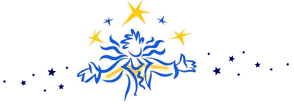 |
1984 |

LE GRAND TOUR
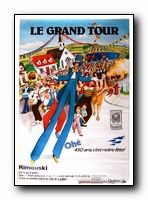 The name, meaning "Sun Circus" or "Circus of the Sun", came to the troupe's
founder Guy Laliberté whilst pondering his future on a white, sandy beach in Hawaii.
"I knew," Laliberte recalls, "that I had to choose a name that would last forever, a
name that would suggest energy and youth and power. So I thought: why not the sun?"
Wishing his new circus to embody youth, energy, power, light and spirit, he naturally
chose the sun as his emblem. Once armed with an identity, the Les Productions du
Cirque du Soleil officially came together on June 16, 1984, and Laliberté’s goal
to bring together creative talent to delight new audiences in new locations takes
a bold step forward. For the festivities, the newly-formed Cirque presents a
totally new concept: a striking, dramatic mix of the circus arts and street
entertainment, featuring wild, outrageous costumes, staged under magical lighting
and set to original music. The The show
debuts in a little 800 seat blue-and-yellow
big top in the small Quebec town of Gaspé, the very same place Mr. Cartier's voyage
took him as he desperately tried to find a land route through to the Orient so long
ago, and continued across 11 towns over the course of 13 weeks (running concurrently
with the third La Fête Foraine) delighting 30,000 spectators.
The name, meaning "Sun Circus" or "Circus of the Sun", came to the troupe's
founder Guy Laliberté whilst pondering his future on a white, sandy beach in Hawaii.
"I knew," Laliberte recalls, "that I had to choose a name that would last forever, a
name that would suggest energy and youth and power. So I thought: why not the sun?"
Wishing his new circus to embody youth, energy, power, light and spirit, he naturally
chose the sun as his emblem. Once armed with an identity, the Les Productions du
Cirque du Soleil officially came together on June 16, 1984, and Laliberté’s goal
to bring together creative talent to delight new audiences in new locations takes
a bold step forward. For the festivities, the newly-formed Cirque presents a
totally new concept: a striking, dramatic mix of the circus arts and street
entertainment, featuring wild, outrageous costumes, staged under magical lighting
and set to original music. The The show
debuts in a little 800 seat blue-and-yellow
big top in the small Quebec town of Gaspé, the very same place Mr. Cartier's voyage
took him as he desperately tried to find a land route through to the Orient so long
ago, and continued across 11 towns over the course of 13 weeks (running concurrently
with the third La Fête Foraine) delighting 30,000 spectators.
It was far from an instant smashing success, however.
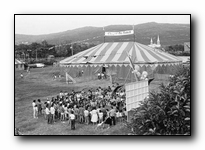
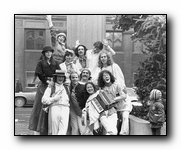
The first shows were riddled with difficulty, starting with the collapse of the
big top thanks to the increased weight of rainwater – the central mast snapped.
Working with a borrowed tent, Laliberté and Co then had to contend with difficulties
from the European performers. They were so unhappy with the Québecois experience,
they had, at one point, sent a letter to the media complaining about how they were
being treated. (Well enough for a street group, apparently not so for an established
circus performer). The problems were only transient, however, and by the time the
festivities came to a close, Le Grand Tour du Cirque du Soleil was a success (one
of the few successful events of the 450th celebration).
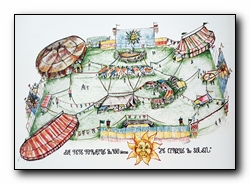 Cirque becomes a multicultural gathering point, with performers from Quebec,
Belgium, Switzerland and Argentina. The crazy dreams of a two friends begin to
take wing. And maybe those dreams aren't so crazy after all. Maybe this idea about
a different kind of circus is something that audiences will respond to. Maybe it will
flourish. Sometimes you just have to trust to fate and follow where your dreams
lead you... Youth, boldness, instinct, vision and a certain zany talent are their
stock in trade.
Cirque becomes a multicultural gathering point, with performers from Quebec,
Belgium, Switzerland and Argentina. The crazy dreams of a two friends begin to
take wing. And maybe those dreams aren't so crazy after all. Maybe this idea about
a different kind of circus is something that audiences will respond to. Maybe it will
flourish. Sometimes you just have to trust to fate and follow where your dreams
lead you... Youth, boldness, instinct, vision and a certain zany talent are their
stock in trade.
And Cirque du Soleil hasn’t stopped since!
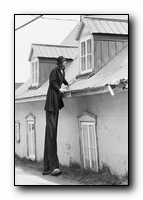 With $60,000 left in the bank, Laliberté went back to the Canadian government to
secure funding for a second year. While the Canadian federal government was enthusiastic
to the idea, the Quebec provincial government was resistant. It was not until Quebec's
Premier, René Lévesque, intervened that the provincial government relented and funding
for the second year was secured. (Consequently, the original big top tent that was used
during the 1984 Le Grand Tour du Cirque du Soleil tour can now be seen at Carnivàle Lune
Bleue, a 1930s-style carnival that is home to the Cirque Maroc acrobats.) With funding
secured, Laliberté took steps to renovate his troupe from a group of street performers
into a "proper circus".
With $60,000 left in the bank, Laliberté went back to the Canadian government to
secure funding for a second year. While the Canadian federal government was enthusiastic
to the idea, the Quebec provincial government was resistant. It was not until Quebec's
Premier, René Lévesque, intervened that the provincial government relented and funding
for the second year was secured. (Consequently, the original big top tent that was used
during the 1984 Le Grand Tour du Cirque du Soleil tour can now be seen at Carnivàle Lune
Bleue, a 1930s-style carnival that is home to the Cirque Maroc acrobats.) With funding
secured, Laliberté took steps to renovate his troupe from a group of street performers
into a "proper circus".


|
|
|
|


![]()





![[Back]](../images/arrow.gif)








